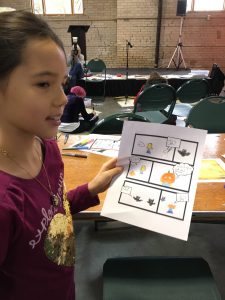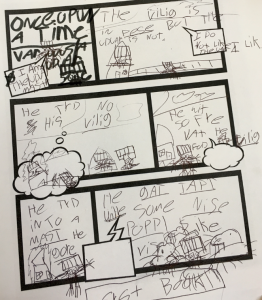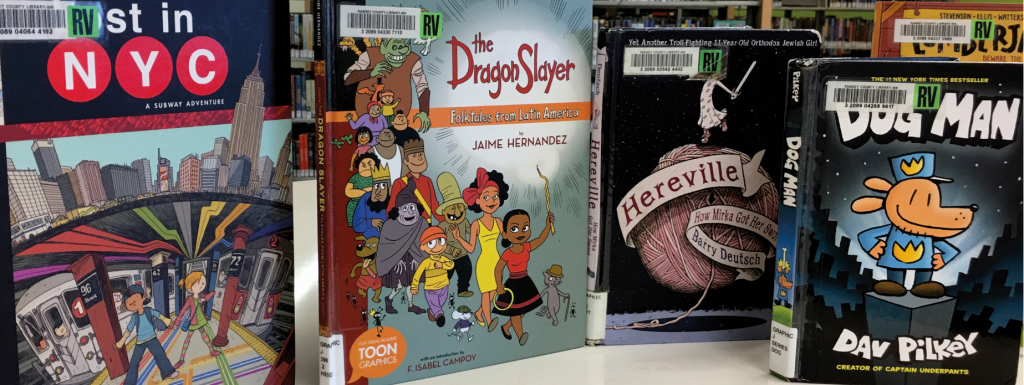7 Comics & Cartoons
I don’t think I’m going out on a limb by saying that every library should have comics and graphic novels as part of its Children’s and Young Adult collections. When I began working as a school librarian in a PreK–8 lab school, we had no comics on our shelves. No Garfield, no Simpsons. My supervisor justified this collection development decision by saying that comics did not support the school curriculum, kids could get them at the public library, we had no money for them, and there was not enough room on the shelves. When kids asked why we didn’t have comics, I answered “The Library Director doesn’t think that comics belong in the school library collection.” (Looking back, I wish I’d said “I’m working on it.”)
Already, though, we owned all of Ed Emberly’s drawing instruction books. From there, it was a short walk to How to Draw the Marvel Way. Then, of course, to the Little Lit, Maus, Adventures of Tintin, Bone, and the Captain Underpants series. The graphic format started to receive national coverage, including articles in School Library Journal, Publishers Weekly, and The New York Times. Trade publishers were creating new imprints, like First Second and Graphix, that produced graphic format specifically for kids and young adults. The No Flying No Tights website appeared on the scene.
I read Understanding Comics: The Invisible Art by Scott McCloud; my eyes were opened, and I was able to articulate what I already knew to be true. Comics are essential materials for high-interest reading. For many resistant readers (those who can read but choose not to), comics are the gateway to improved literacy, to greater reading comprehension and fluency.


I use the terms comics, graphic narrative, and graphic format interchangeably; they are all forms of illustrated, sequential storytelling or communication. Any topic can be explored using graphic format; it can encompass informational, autobiographical, speculative, or contemporary content, and more.
Talking with my supervisor at the time, I contended that comics and graphic format supported our literacy curriculum as well as the use of cross-genre writing. That year I spent my entire materials budget on comic-format books.
Teachers in our school began incorporating titles like Persepolis, an autobiographical graphic novel by Marjane Satrapi, into the eighth-grade social studies curriculum; Régis Faller’s comic picture book The Adventures of Polo into the second-grade literacy program; and George O’Connor’s Olympians series into the Upper School’s mythology curriculum.
This format was perfect for resistant readers AND fluent ones. I became evangelical. Eventually, the classroom teachers and I partnered in creating a comic curriculum for our fourth graders. And we created comics in the library.
To provide a brief overview of the benefits of comics, the Comic Book Defense League has published Raising a Reader: How Comics & Graphic Novels Can Help Your Kids Love to Read! by Meryl Jaffe, PhD, with foreword and illustrations by Jennifer Holm (z.umn.edu/wbr70).
The revolution is over. In January, 2016, comic/graphic writer and artist Gene Yang was appointed the National Ambassador for Young People’s Literature by the Library of Congress and the Children’s Book Council.
Comics have won their place in the library and the classroom.

Mentor texts
Young
Cammuso, Frank, and Jay Lynch. 2008. Otto’s Orange Day. New York: Toon Books.
Castellucci, Cecil, and Sara Varon. 2013. Odd Duck. 1st ed. New York: First Second.
Davis, Eleanor. 2008. Stinky, Toon Level 2. New York: Toon Books.
Davis, Jim. 1982. Garfield Treasury. 1st ed. New York: Ballantine Books.
Elder, Joshua, and Chris Giarrusso. 2014. Reading with Pictures: Comics That Make Kids Smarter! Kansas City, Missouri: Andrews McMeel Publishing. still image.
Faller, Régis. 2006. The Adventures of Polo. 1st American ed. New Milford, CT: Roaring Brook.
Hayes, Geoffrey. 2009. Benny and Penny in the Big No-No! A Toon Book. New York: Toon Books.
Meister, Cari, and Marilyn Janovitz. 2010. Airplane Adventure, My 1st Graphic Novel. Minneapolis, Minn.: Stone Arch Books.
Rosenstiehl, Agnès. 2008. Silly Lilly and the Four Seasons. New York: RAW Junior.
Runton, Andy. 2004. Owly. Marietta, Ga.: Top Shelf.
Smith, Jeff. 2009. Little Mouse Gets Ready: A Toon Book. New York: Toon Books.
Venable, Colleen A. F., and Stephanie Yue. 2010. Hamster and Cheese, Guinea Pig, Pet Shop Private Eye. Minneapolis: Graphic Universe.
Weitzman, Jacqueline Preiss, and Robin Preiss-Glasser. 2002. You Can’t Take a Balloon into the Museum of Fine Arts. New York: Dial Books for Young Readers.
Middle Grades
Bell, Cece, and David Lasky. 2014. El Deafo. New York, NY: Amulet Books.
Gownley, Jimmy. 2010. When the Past Is a Present. New York: Atheneum Books for Young Readers.
Guibert, Emmanuel, Joann Sfar, and Emmanuel Guibert. 2006. Sardine in Outer Space. New York: First Second.
Hatke, Ben. 2010. Far from Home. 1st ed, Zita the Spacegirl. New York: First Second.
Hergé. 1959. The Secret of the Unicorn, The Adventures of Tintin. New York: Golden Press.
Holm, Jennifer L., and Matthew Holm. 2005. Babymouse: Queen of the World! 1st ed. New York: Random House Children’s Books.
Holm, Jennifer L., and Matthew Holm. 2011. Squish, Super Amoeba. Squish. New York: Random House.
Jamieson, Victoria. 2015. Roller Girl. New York: Dial Books.
Kibuishi, Kazu. 2008. The Stonekeeper. Amulet. New York: Graphix.
Krosoczka, Jarrett. 2009. Lunch Lady and the Cyborg Substitute. New York: Alfred A. Knopf.
Larson, Hope. 2008. Chiggers. 1st ed. New York: Atheneum Books for Young Readers.
Larson, Hope, and Madeleine L’Engle. 2012. A Wrinkle in Time: The Graphic Novel. New York: Farrar Straus Giroux.
Lewis, John, Andrew Aydin, Nate Powell, and Small Press Expo Collection (Library of Congress). 2013. March: Book One. Marietta, GA: Top Shelf Productions. still image.
Mack, Stanley, and Susan Champlin. 2009. Road to Revolution! The Cartoon Chronicles of America. New York: Bloomsbury.
McDuffie, Dwayne, Robert L. Washington, John Paul Leon, Denys Cowan, Derek T. Dingle, and Michael Davis. 2009. Static Shock: Rebirth of the Cool. New York: DC Comics.
Nobleman, Marc Tyler, and Ross MacDonald. 2008. Boys of Steel: The Creators of Superman. 1st ed. 1 vols. New York: A.A. Knopf.
O’Connor, George. 2010. Zeus: King of the Gods. Olympians. New York: First Second.
Peirce, Lincoln. 2012. Big Nate: What Could Possibly Go Wrong? New York, NY: Harper.
Pilkey, Dav. 2010. The Adventures of Ook and Gluk: Kung-Fu Cavemen from the Future. New York: Scholastic.
Robbins, Trina. 2007. Bessie Coleman: Daring Stunt Pilot, Graphic Library Graphic Biographies. Mankato, MN.: Capstone.
Siegel, Siena Cherson, and Mark Siegel. 2006. To Dance: A Memoir. New York: Atheneum Books for Young Readers.
Soo, Kean. 2008. Jellaby. New York: Hyperion Books for Children.
Spiegelman, Nadja, and Sergio García Sánchez. 2015. Lost in NYC: A Subway Adventure: A Toon Graphic. New York, NY: TOON Books.
Spiegelman, Nadja, and Sergio García Sánchez. 2015. Perdidos En Nyc: Una Aventura En El Metro: A Toon Graphic (Spanish Edition). New York, NY: TOON Books.
Spires, Ashley. 2012. Binky Takes Charge (a Binky Adventure). Tonawanda, NY: Kids Can Press Ltd.
Sturm, James, Andrew Arnold, Alexis Frederick-Frost, and Center for Cartoon Studies. 2009. Adventures in Cartooning. New York: First Second.
Telgemeier, Raina. 2010. Smile. New York: Graphix.
Telgemeier, Raina, and Gurihiru. 2012. Drama. New York: Graphix.
Varon, Sara. 2007. Robot Dreams. New York: First Second.
Varon, Sara. 2011. Bake Sale. New York: First Second.
Watterson, Bill. 1990. The Authoritative Calvin and Hobbes: A Calvin and Hobbes Treasury. Kansas City: Andrews and McMeel.
Yang, Gene Luen, and Gurihiru. 2014. The Search. Milwaukie, OR: Dark Horse Books.
Yang, Gene Luen, Sonny Liew, and Janice Chiang. 2014. The Shadow Hero. New York: First Second.
Yolen, Jane, and Michael Cavallaro. 2010. Foiled. New York: First Second.
Ages 12 and up
Bechdel, Alison. 2006. Fun Home: A Family Tragicomic. Boston: Houghton Mifflin.
Long, Mark, and Jim Demonakos. 2012. The Silence of Our Friends. New York: First Second.
Nicholas, Jamar, and Geoffrey Canada. 2010. Fist, Stick, Knife, Gun: A Personal History of Violence. Boston, MA: Beacon Press.
Roman, Dave, and John Green. 2015. Teen Boat! The Race for Boatlantis. New York: Clarion Books.
Satrapi, Marjane. 2003. Persepolis. New York: Pantheon Books.
Sautter, Aaron, Erik Doescher, and Tim Levins. 2015. How to Draw Batman, Superman, and Other Dc Super Heroes and Villains. North Mankato, MN: Capstone Young Readers.
Sims, Guy A., Dawud Anyabwile, and Walter Dean Myers. 2015. Monster: A Graphic Novel. First edition. ed. New York, NY: Amistad.
Small, David. 2009. Stitches: A Memoir. 1st ed. New York: W.W. Norton & Co.
Spiegelman, Art. 1986. Maus: A Survivor’s Tale. New York: Pantheon Books.
Tamaki, Mariko, and Jillian Tamaki. 2010. Skim. Toronto: Groundwood Books/House of Anansi Press.
Tamaki, Mariko, Jillian Tamaki, and Small Press Expo Collection (Library of Congress). 2014. This One Summer. New York: First Second.
White, Tracy. 2010. How I Made It to Eighteen: A Mostly True Story. New York: Roaring Brook Press.
Resources
Amara, Philip. 2012. So, You Want to Be a Comic Book Artist? The Ultimate Guide on How to Break into Comics! New York: Aladdin, Beyond Words.
Bakis, Maureen. 2012. The Graphic Novel Classroom: Powerful Teaching and Learning with Images. Thousand Oaks, CA.: Corwin Press.
Frey, Nancy, and Douglas Fisher. 2008. Teaching Visual Literacy: Using Comic Books, Graphic Novels, Anime, Cartoons, and More to Develop Comprehension and Thinking Skills. Thousand Oaks, CA: Corwin Press.
Jaffe, Meryl. 2013. Using Content-Area Graphic Texts for Learning: A Guide for Middle-Level Educators. Gainesville, FL: Maupin House Pub.
McCloud, Scott. 1993. Understanding Comics: The Invisible Art. Northampton, MA: Tundra Pub.
McKee, Lori L, and Rachel M Heydon. 2015. “Orchestrating Literacies: Print Literacy Learning Opportunities within Multimodal Intergenerational Ensembles.” Journal of Early Childhood Literacy 15 (2):227-255.
Monnin, Katie. 2010. Teaching Graphic Novels: Practical Strategies for the Secondary ELA Classroom. Gainesville, FL: Maupin House Pub.
Monnin, Katie. 2011. Teaching Early Reader Comics and Graphic Novels. Gainesville, FL: Maupin House Pub.
Morawek, Alison. 2011. “Get Cooking with Words! Creating a Recipe Using Procedural Writing.”
Rothschild, D. Aviva. 1995. Graphic Novels: A Bibliographic Guide to Book-Length Comics. Englewood, CO: Libraries Unlimited.
Tabachnick, Stephen Ely. 2009. Teaching the Graphic Novel, Options for Teaching. New York: The Modern Language Association of America.
Weger Bowman, Elayne. 2015. “Embracing Common Core State Standards One Project at a Time.” The Clearing House: A Journal of Educational Strategies, Issues and Ideas 88 (3):91-95.
Websites
Graphic Novel Reporter (graphicnovelreporter.com): teacher links and suggestions.
ReadWriteThink (readwritethink.org): lesson plans and activity ideas for graphic novels.
Comic Book Legal Defense Fund (cbldf.org/using-graphic-novels): column on Using Graphic Novels in Education.
The National Council for Teachers of English (ncte.org).

